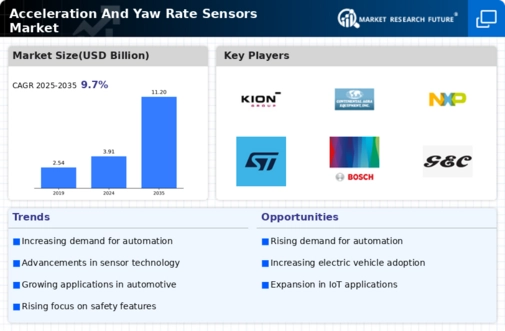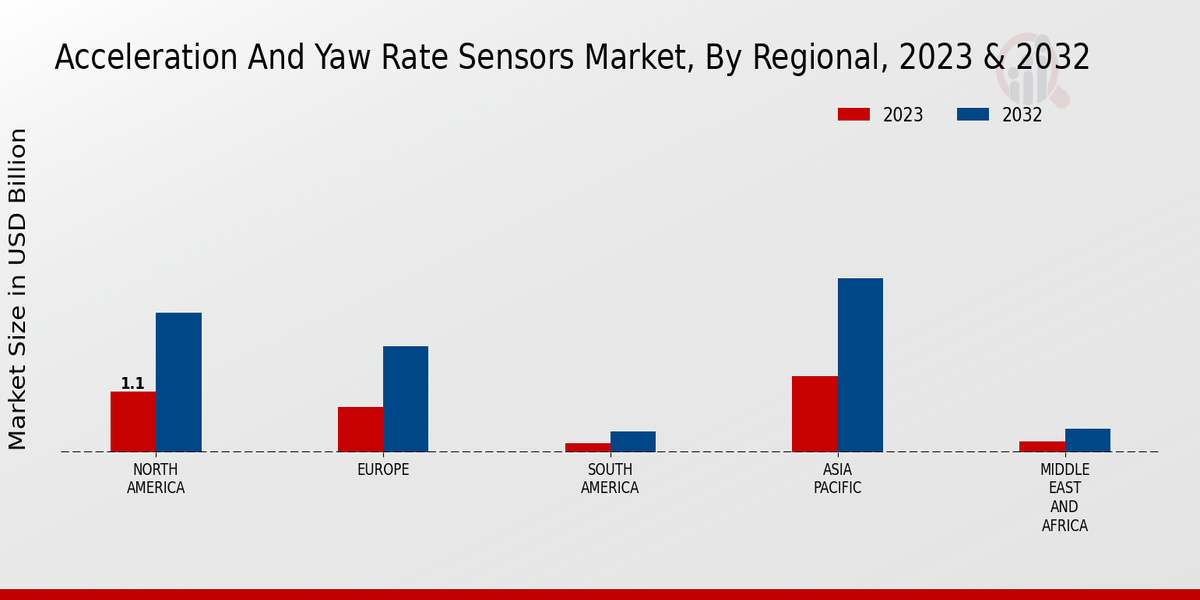Growth in Automotive Sector
The Global Acceleration And Yaw Rate Sensors Market Industry is significantly influenced by the robust growth of the automotive sector. With the increasing production of vehicles, manufacturers are incorporating advanced sensors to improve vehicle stability and handling. The market is expected to grow from 3.91 USD Billion in 2024 to an estimated 11.2 USD Billion by 2035, reflecting a compound annual growth rate (CAGR) of 10.01% from 2025 to 2035. This growth trajectory indicates a strong demand for enhanced vehicle performance and safety features, driving the integration of acceleration and yaw rate sensors in modern vehicles. The automotive industry's evolution towards electrification and automation further amplifies this trend.
Emergence of Autonomous Vehicles
The emergence of autonomous vehicles is poised to transform the Global Acceleration And Yaw Rate Sensors Market Industry. As the automotive industry shifts towards automation, the demand for precise vehicle dynamics monitoring becomes paramount. Acceleration and yaw rate sensors are critical components in enabling autonomous driving technologies, as they provide essential data for vehicle control systems. This trend is likely to drive significant investments in sensor technologies, as manufacturers seek to enhance the safety and reliability of autonomous vehicles. The anticipated growth in this sector may further stimulate the Global Acceleration And Yaw Rate Sensors Market Industry, positioning it for a dynamic future.
Increasing Focus on Vehicle Safety Regulations
The Global Acceleration And Yaw Rate Sensors Market Industry is significantly impacted by the increasing focus on vehicle safety regulations across various regions. Governments worldwide are implementing stringent safety standards that require the integration of advanced safety features in vehicles. This regulatory landscape compels manufacturers to adopt acceleration and yaw rate sensors to comply with safety mandates. For example, the European Union has established regulations that necessitate the use of these sensors in new vehicle models. As a result, the market is expected to expand as automotive manufacturers prioritize compliance with safety regulations, thereby driving the demand for these sensors.
Technological Advancements in Sensor Technology
Technological advancements play a pivotal role in shaping the Global Acceleration And Yaw Rate Sensors Market Industry. Innovations in sensor technology, such as miniaturization and improved accuracy, enhance the performance of these sensors in various applications. For instance, the integration of MEMS (Micro-Electro-Mechanical Systems) technology has led to more compact and efficient sensors, which are increasingly used in automotive applications. These advancements not only improve the reliability of vehicle dynamics monitoring but also reduce production costs, making it feasible for manufacturers to adopt these technologies. As a result, the market is likely to witness accelerated growth driven by these technological innovations.
Rising Demand for Advanced Driver Assistance Systems
The Global Acceleration And Yaw Rate Sensors Market Industry experiences a notable surge in demand due to the increasing adoption of advanced driver assistance systems (ADAS). These systems enhance vehicle safety and performance by utilizing acceleration and yaw rate sensors to monitor vehicle dynamics. As consumers prioritize safety features, the market is projected to reach 3.91 USD Billion in 2024. This growth is further fueled by regulatory mandates for safety technologies in vehicles, compelling manufacturers to integrate these sensors into their designs. Consequently, the Global Acceleration And Yaw Rate Sensors Market Industry is poised for substantial expansion as automotive companies innovate to meet consumer expectations.



















Leave a Comment